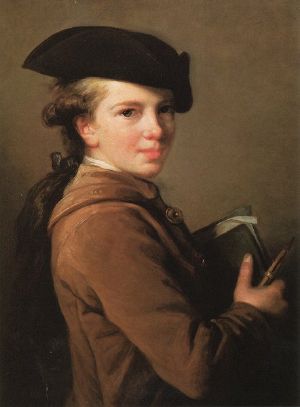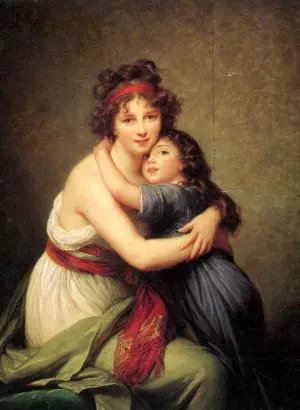Élisabeth-Louise Vigée-Le Brun
| Élisabeth-Louise Vigée-Le Brun | |
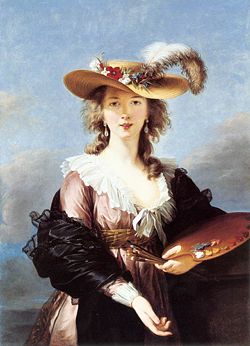 Self-portrait in a Straw Hat, 1782. | |
| Birth name | Marie Élisabeth-Louise Vigée |
| Born | April 16 1755 Paris, France |
| Died | March 30 1842 (aged 86) Paris, France |
| Nationality | |
| Field | Painting |
| Movement | Rococo |
Élisabeth-Louise Vigée-Le Brun (April 16, 1755 - March 30, 1842) was a French portraitist, who is best remembered for her portraits of Marie Antoinette, and for her disarming self portraits which reflect her life and career at various stages: young motherhood, life in exile after fleeing France during the French Revolution, and mature portraitist of European nobility. Now, generally regarded as the most famous woman painter of the eighteenth century, she was under rated for many years not only because of her association with the unpopular ancien regime, but also due to the fact that she excelled in a field largely dominated by male artists and their patrons.
Her style influenced by Jacques-Louis David came into its own as the Rococo period was waning and neoclassicalism was becoming popular with its themes connected to Greek and Roman times. One can see her love for naturalism, influenced by the philosophy of Jean-Jacques Rousseau, reflected in her portraits of Marie Antoinette; portraits in which the queen is dressed more simply and is embracing her children. In her later portraits one can see the influence of Romanticism with naturalistic settings involving landscapes and waterfalls serving as backgrounds to her portraits. Vigee Le-Brun worked tirelessly at her craft and career which spanned many decades and several European countries, finding unprecedented success for a women through a time of great social and political upheaval in Europe. While artistic recognition might have been late in coming, her portraits now hang in all the leading art museums of the world.[1]
Early life as a prodigy
She was born in Paris on 16 April 1755, Marie Élisabeth-Louise Vigée, the daughter of portraitist and pastellist, Louis Vigée. In the early stages of her career she would owe a great deal to the connections she made in the art world through her father. She had a strained relationship with her mother, a hairdresser.[2] She was sent to live with relatives in Epernon until the age of six when she entered a convent where she remained for five years. This type of education was customary for girls from the upper classes who were expected to learn social graces, along with reading, writing and embroidery skills. However, the young Vigee was reprimanded on more than one occasion for drawing on her dormitory walls. I remember at the age of seven or eight I drew by the lamp a head of a bearded man which I have always kept. I showed it to my father who cried out with joy, "You shall be a painter, my child! Her father died when she was 12 years old and in 1768, her mother married wealthy jeweler, Jacques-Francois Le Sèvre. This was a difficult adjustment for Vigee LeBrun who was close to her father, but when the family moved to the rue Saint-Honoré close to the Palais Royal this afforded her new opportunities for drawing. During this period the youthful artist was mentored by masters of the day including Jean-Baptiste Greuze, Joseph Vernet, and Herbert Robert, the latter two whose portraits she painted.
By the time she was in her early teens, Elisabeth was painting portraits professionally. In her memoirs, Souvenirs she attests to the fact that she was largely a self taught artist and did not have the opportunity to study under the official curriculum of the Academie, however, she did to apply to the lest prestigious Académie de Saint Luc, of which her father had been a member, and they willingly exhibited her works in their Salon. One of her early portraits, painted when she was a teenager is of her younger brother Etienne. In the book, Elisabeth Vigee Le Brun, The Odyssey of an Artists in an Age of Revolution, Gita May states that, 'The portrait of Etienne is a striking example of Vigee LeBrun's prodigious and precocious talent, especially at capturing a personality in an unselfconscious moment of introspection and self revelation. [3]
Influences
Royal Court Portraitist
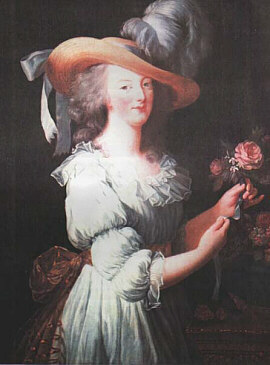
On 7 August 1775 she married Jean-Baptiste-Pierre Le Brun, a painter and art dealer. Vigée-Le Brun painted portraits of many of the nobility of the day and as her career blossomed, she was invited to the Palace of Versailles to paint Marie Antoinette, the French Queen consort.
So pleased was the queen that over the next several years, Vigée-Le Brun was commissioned to do numerous portraits of the queen, her children, and other members of the royal family and household. On 12 February1780 Vigée-Le Brun gave birth to a daughter Jeanne Julie Louise, whom she called "Julie."
In 1781 she and her husband toured Flanders and the Netherlands where seeing the works of the Flemish masters inspired her to try new techniques. There, she painted portraits of some of the nobility, including the Prince of Nassau.
On May 31, 1783, Vigée Le Brun was accepted as a member of France's Académie Royale de Peinture et de Sculpture as a painter of historical allegory. Adélaïde Labille-Guiard also was admitted on the same day.
The admission of Vigée-Le Brun was opposed on the grounds that her husband was an art dealer, but eventually they were overruled by an order from Louis XVI because Marie-Antoinette put considerable pressure on her husband on behalf of her painter.
The admission of more than one woman on the same day to the Académie encouraged comparisons among the works of the women instead of one woman contrasted with the existing members, who were men.
In 1789, she was succeeded as court painter to Marie Antoinette by Alexander Kucharsky.
French Revolution and exile
After the arrest of the royal family during the French Revolution Vigée-Le Brun fled France with her young daughter Julie. She lived and worked for some years in Italy, Austria, and Russia, where her experience in dealing with an aristocratic clientèle was still useful. In Rome, her paintings met with great critical acclaim and she was elected to the Roman Accademia di San Luca.
In Russia, she was received by the nobility and painted numerous members of the family of Catherine the Great. While there, Vigée-Le Brun was made a member of the Academy of Fine Arts of Saint Petersburg. Much to Vigée-Le Brun's dismay, Julie married a Russian nobleman.[4]
She was welcomed back to France during the reign of Emperor Napoleon I. Much in demand by the élite of Europe, she visited England at the beginning of the nineteenth century and painted the portrait of several British notables including Lord Byron. In 1807 she traveled to Switzerland and was made an honorary member of the Société pour l'Avancement des Beaux-Arts of Geneva.
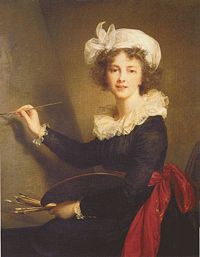
She published her memoirs in 1835 and 1837, which provide an interesting view of the training of artists at the end of the period dominated by royal academies. Her portrait of fellow neoclassical painter, Hubert Robert, is in Paris at Musee National du Louvre.
End of life
Still very active with her painting in her fifties, she purchased a house in Louveciennes, Île-de-France, and lived there until the house was seized by the Prussian Army during the war in 1814. She stayed in Paris until her death on March 30, 1842 when her body was taken back to Louveciennes and buried in the cemetery near her old home.
Her tombstone epitaph states "Ici, enfin, je repose…" (Here, at last, I rest…).
Legacy
Vigée-Le Brun left a legacy of 660 portraits and 200 landscapes. In addition to private collections, her works may be found at major museums, such as Hermitage Museum, London's National Gallery, in Europe and the United States.
Notes
- ↑ May, Gita. Elisabeth Vigée Le Brun: The Odyssey of an Artist in an Age of Revolution, 2005. Conn. New Haven: Yale University Press.
- ↑ CyberPathways Art World
- ↑ May, Gita. Elisabeth Vigée Le Brun: The Odyssey of an Artist in an Age of Revolution, 2005. Conn. New Haven: Yale University Press.
- ↑ CyberPathways Art World
ReferencesISBN links support NWE through referral fees
This article incorporates text from the Encyclopædia Britannica Eleventh Edition, a publication now in the public domain.
- "Elisabeth (Louise) Vigee-Le Brun." International Dictionary of Art and Artists. St. James Press. 1990. Reproduced in Biography Resource Center. Farmington Hills, Mich.: Gale 2009.
- "Elisabeth Vigee LeBrun." Encyclopedia of World Biography. Vol. 19. Gale Group, 1999. Reproduced in Biography Resource Center. Farmington Hills, Mich.: Gale, 2009.
- May, Gita. Elisabeth Vigée Le Brun: The Odyssey of an Artist in an Age of Revolution, 2005. Conn. New Haven: Yale University Press. ISBN 9780300108729
Further Reading
- Goodden, Angelica. 1997. The Sweetness of Life: A Biography of Elisabeth Louise Vigée Le Brun. London: Andre Deutsch. ISBN 0233990216
- Sheriff, Mary D. 1996. The Exceptional Woman: Elisabeth Vigée-Lebrun and the Cultural Politics of Art. Chicago, Ill: University of Chicago Press. ISBN 0226752755
- Vigée-Lebrun, Louise-Elisabeth. 1950. The Memoirs of Mme Elisabeth Louise Vigée-le Brun, 1755-1789. New York: George H. Doran. OCLC 155723784
- Vigée-Le Brun, Louise-Élisabeth, and Claudine Herrmann. 1984. Souvenirs. 2. Paris: Des Femmes. OCLC 79301947
External links
- Large gallery of Vigée-LeBrun's work; also articles, Memoirs, biographies
- Artcyclopedia entry on Elisabeth Vigée-Lebrun
- Vigée-Lebrun's Portrait of Carlo Gastone della Torre di Rezzonico at artnet
- Old Masters: Overlooked Women Artists
- Memoirs of Madame Vigée-Lebrun, translated by Lionel Strachey
- Neil Jeffares, Dictionary of pastellists before 1800, online edition
| Persondata | |
|---|---|
| NAME | Brun, Élisabeth-Louise Vigée-Le |
| ALTERNATIVE NAMES | Vigée, Marie Élisabeth-Louise |
| SHORT DESCRIPTION | French painter |
| DATE OF BIRTH | April 16 1755 |
| PLACE OF BIRTH | Paris, France |
| DATE OF DEATH | March 30 1842 |
| PLACE OF DEATH | Paris, France |
Credits
New World Encyclopedia writers and editors rewrote and completed the Wikipedia article in accordance with New World Encyclopedia standards. This article abides by terms of the Creative Commons CC-by-sa 3.0 License (CC-by-sa), which may be used and disseminated with proper attribution. Credit is due under the terms of this license that can reference both the New World Encyclopedia contributors and the selfless volunteer contributors of the Wikimedia Foundation. To cite this article click here for a list of acceptable citing formats.The history of earlier contributions by wikipedians is accessible to researchers here:
The history of this article since it was imported to New World Encyclopedia:
Note: Some restrictions may apply to use of individual images which are separately licensed.
